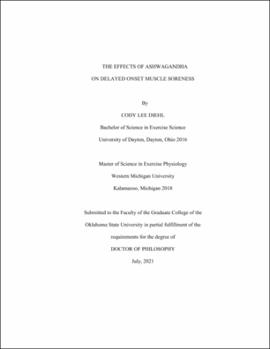| dc.description.abstract | Delayed onset muscle soreness (DOMS), is a phenomenon that typically occurs within 8-48 hours, and can peak within 24-72 hours after a bout of intense resistance training[1]. To combat this pain, analgesics such as Nonsteroidal Anti-inflammatory Drugs (NSAIDs) are commonly used. Many negative risks and side effects are associated with NSAID use including but not limited to: gastrointestinal (GI) distress, ulcers, hypertension, acute renal failure, and other cardiovascular related incidences [25]. Ashwagandha is an Indian herbal supplement believed to have anti-inflammatory and analgesic properties. The purpose of this study was to assess the effects of Ashwagandha on DOMS following a bout of intense exercise. Fifteen (n=15) college aged individuals (18-23 years of age), volunteered to participate in this study and were randomly placed in either an experimental condition (n=8), (750mg dose of Ashwagandha), or a placebo condition (n=7). The subjects completed an intense lower-body exercise protocol consisting of 5 sets of 20 weighted lunges at 40% body weight, along with 3 sets to failure of 75% body weight on a leg press machine. Testing measurements consisted of a Visual Analog Scale (VAS), pain pressure threshold, thigh circumference, peak power output, ground contact time, peak velocity, and vertical jump. Measurements were taken at pre-test, post resistance training bout, day 3, and day 6. VAS measurements were recorded days 1-5. Statistical analysis showed a statistically significant difference in peak power (W) output on Day 3 in the experimental group, (M= 1659.873, SD 614.104) compared to the control group (M=1401.214, SD= 306.669), t(10.558)=1.051, p<0.016. No other measurements showed statistically significant difference among the groups. This demonstrates Ashwagandha has the ability to improve, or maintain peak power output measures on the third day following an intense bout of lower body resistance training exercises. | |
